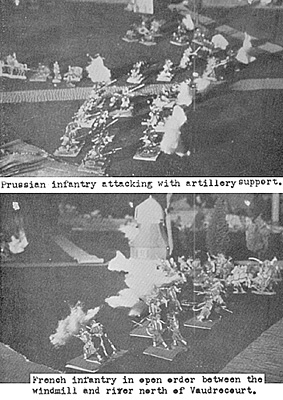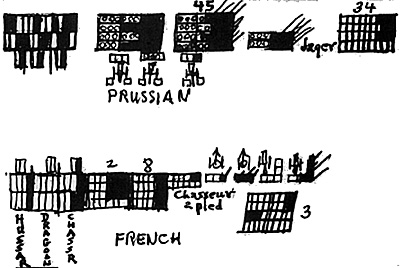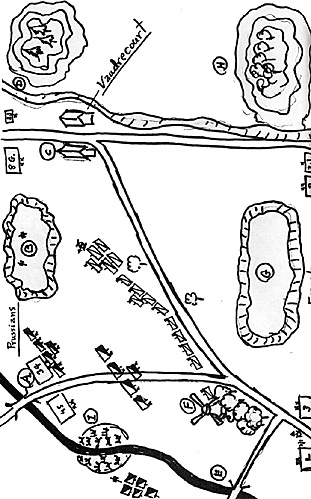 This Franco-Prussian game amounted to a competitive field test of
the Volume I No. 2 and No. 3 late 19th century rules. For various reasons I
employed the roster system. The T.O. (Table of organization) appears in figure
2. Each force comprised about a brigade of infantry, a brigade of cavalry, and a
"jager" (or chasseur a pied) battalion. The total forces were 9 battalions of 12
figures each of infantry on either side, I battalion of 12 jagers on either side, and
15 squadrons (I command squadron equivalent per regiment) of cavalry on either
side, i.e. 30 troopers. The Prussians had one horse and two field batteries, the
French two field batteries and one each horse and field mitrailleuse sections
(representing 2 rather than 6 weapons per the rules.)
This Franco-Prussian game amounted to a competitive field test of
the Volume I No. 2 and No. 3 late 19th century rules. For various reasons I
employed the roster system. The T.O. (Table of organization) appears in figure
2. Each force comprised about a brigade of infantry, a brigade of cavalry, and a
"jager" (or chasseur a pied) battalion. The total forces were 9 battalions of 12
figures each of infantry on either side, I battalion of 12 jagers on either side, and
15 squadrons (I command squadron equivalent per regiment) of cavalry on either
side, i.e. 30 troopers. The Prussians had one horse and two field batteries, the
French two field batteries and one each horse and field mitrailleuse sections
(representing 2 rather than 6 weapons per the rules.)
Cavalry and horse artillery appeared 4 turns in advance as a screen. Heavy cavalry here moved 2" slower, light 2" faster than line, which moved according to the basic rate. The Le Kriegspiel differential of I point per light trooper, 1.5 for medium, and 2.0 for heavy was used, but with no special value for officer or cadre.
The Prussians sent 2 regiments-cuirassiers and dragoons (light) between Bridge A & Hill B. The 8th Uhlans, with the horse battery, trotted over the bridge towards swamp 1.
The French cavalry brigade had hussars in extended order between Mill F and Hill H, chasseurs a cheval on the Vaudrecourt (c) road with the mitrailleuse section. The dragoons were trotting towards Mill F.
This situation presented the French player with an opportunity to mass three mounted regiments on - two. Melee power, however, was only 50 to 40 allowing I point per base for impetus. The Prussian helped, however, by allowing his dragoons, being light, to outstrip their heavy colleagues, and then charging them down on the French (medium) dragoons. I squadron of the latter had tied horses and occupied the Mill, but a charge by the hussars on the flank squared things. (I suspect my opponent to have been confused here by use of diagonally opposite movement.) Supporting weapons went into action at this point, 2 cuirassiers falling to the mitrailleuse and 1 chasseur to the horse battery. The French Hussars pursued for one turn, reducing the Prussians below 50%, but losing one of their own to the vengeful Cuirassiers as they fled the scene in skirmish order.
All dragoons were now dismounted in the Mill, the Chasseurs a cheval going on to Vaudrecourt with the mitrailleuse. Infantry was coming on, and the Prussian Uhlans and Cuirassiers threatened the flank of the leading French Infantry battallion.
Each side now came on with 2 regiments on the A-F road, 1 regiment with 1 jager battallion on the C-H road. Two Prussian batteries deployed on Hill B and began to shell the oncoming French route columns. One French battery was laboriously ascending the Hill H to support the dismounted cavalry at Vaudrecourt (C). Remaining French artillery was behind the infantry near Mill F. The lead battallion of the French 2nd Regiment fronted towards the Prussian cavalry and advanced firing slowly. One company went to ground with 30% casualties (1 killed, low morale roll) due to horse artillery fire. If another had gone before the Prussian cavalry broke (it had been wavering under long range fire for some turns) it might have led to a successful cavalry charge across the route columns of the main French force, but after doggedly milling under fire the Prussian cavalry went under 50% and left by way of the bridge (E). After coming under infantry fire at 400 yds (24") the Prussian battery took a casualty and retired.
Very soon, under a crossfire from the 2nd Jagers and a Prussian battery, the French horseholders fled Vaudrecourt, and the gun teams there were shot down. Although persisting in the attempt for two turns, the French player (c'est moi) abandoned the attempt to reach Vaudrecourt by the H-C road in column of route. No sooner did a company emerge from the region of Hill G (behind which the Hussard were hiding) than it would lose personnel and disperse towards the rear. The same obtained on the other road-the Prussian guns were dominating the battlefield and isolating the garrison of Vaudrecourt.
 Against the latter point advanced the 8th Grenadiers (no special rules
apply) in deep order. The Jagers, firing furiously, were flanking to the hill side.
Four cavalry bases, with the fire effect of 2 infantry companies, supported by I
mitrailleuse section and the fire of I battery were facing 12 infantry companies
and 4 of Jagers.
Against the latter point advanced the 8th Grenadiers (no special rules
apply) in deep order. The Jagers, firing furiously, were flanking to the hill side.
Four cavalry bases, with the fire effect of 2 infantry companies, supported by I
mitrailleuse section and the fire of I battery were facing 12 infantry companies
and 4 of Jagers.
For three turns the 8th Grenadier pushed on with high morale, firing- little, but suffering heavy casualties. I believe a third were out when the final charge began, a result of carbine, canon, and mitrailleuse. In the final charge each house had a defense factor of 12, each garrison either 1.5 or 2. Putting about 13 points on each building, roughly I to 1 odds, the Grenadiers with 1 base of Jagers closed in. The Mitrailleuse crew, working from behind the right house, added to the fire power, but did not melee. At this point the French got lucky and won both melees. Being low on personnel, they achieved only I kill per melee (wounded & prisoners require, under Le Kriegspiel, 1h the manpower or personal melee value of the defeated unit.) Even so, the grenadiers were out of it, going under 50% as they fled under fire.
The other three Jager bases (9 figures) then set about flanking the town and mowed down the Mitrailleurs, survivors taking refuge in the buildings. Turning, they proceeded in a couple of turns, to silence the French battery on Hill H. They also dropped another trooper, who was trying vainly to hit them with a carbine from a window.
On the other flank French infantry had relieved the dragoons at the Mill F. (I should have mentioned-we penalized cavalry 10" or 200yds fire accuracy with attendant decrease in effect.) The dragoons joined the hussars - hiding behind Hill G.
For several turns the French infantry engaged the more densely ordered 34th Fusiliers and 45th Infantry from Mill F and the wood as well as the open field before the French artillery and the Prussian horse battery joined in at close range. The Prussian battery did some execution but, being within medium range of the Mill, was soon silenced.
Having the edge in position and some support from the artillery (out of line of sight from the Prussian guns) the French gradually gained ground. The 8th regiment on the Baudrecourt road area fanned out bringing the Jagers and the Prussian main force under long range fire. Not, however, until 2 companies of French Chasseurs a Pied ascended the Hill H were the deadly greencoats finally dispersed. At about the same time the 45th infantry gave way and, with the 34th Fusiliers as a rear guard, the Prussians quit the field. The French cavalry made no move to harass the doughty fusiliers, instead departing up the Vaudrecourt Road in hopes of catching the grenadiers or jagers before the latter could reform.
Either in the cavalry threat to the initial French infantry advance, or the bayonet attack on Vaudrecourt dice might have easily thrown things more to the Prussian satisfaction, On the other hand, since the gunfire form Hill B drastically curtailed French movement, there was time for the Jagers to take out the Mitrailleuse and for the Grenadiers to approach firing in a more open order until close enough for a charge. Deviding the cavalry also seems a mistake in retrospect, but the flanking gun was a significant threat and may have justified the risk.
Critics will justly question the staying power of my dismounted chasseurs a cheval -- I can only say that I did not expect them to hold once my road columns were pinned, but that French chasseurs a cheval did, at the time, carry an excellent breechloading carbine, and they were facing an attack with relatively little incoming fire- it might as well have been Zulus, except for the speed. Melee value assigned to the defending cavalry was only 14 pt. per man.
All in all my opponent, Mr. Dick Bryant of the New England Wargames Club showed considerable resource in the use of his Jagers and artillery--being handicapped in the use of other arms, I suspect, by a Napoleonic wargames background.

Back to The Armchair General Vol. 2 No. 2 Table of Contents
Back to The Armchair General List of Issues
Back to MagWeb Master Magazine List
© Copyright 1969 by Pat Condray
This article appears in MagWeb (Magazine Web) on the Internet World Wide Web. Other military history articles and gaming articles are available at http://www.magweb.com
